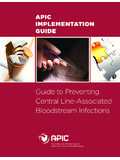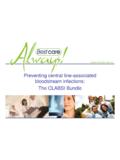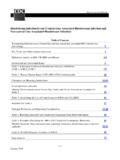Transcription of Guideline for Hand Hygiene in Health-Care Settings
1 Morbidity and Mortality Weekly Report Recommendations and Reports October 25, 2002 / Vol. 51 / No. RR-16. Guideline for Hand Hygiene in Health-Care Settings Recommendations of the Healthcare Infection control Practices Advisory Committee and the HICPAC/SHEA/APIC/IDSA. Hand Hygiene Task Force INSIDE: Continuing Education Examination centers for disease control and prevention TM. SAFER HEALTHIER. HEALTHIER PEOPLE. MMWR. CONTENTS. Part I. Review of the Scientific Data Regarding The MMWR series of publications is published by the Epidemiology Program Office, Centers for disease Hand Hygiene .. 1. control and prevention (CDC), Department of Historical Perspective .. 1. health and Human Services, Atlanta, GA 30333. Normal Bacterial Skin Flora .. 2. Physiology of Normal Skin .. 2. SUGGESTED CITATION Definition of Terms .. 3. centers for disease control and prevention . Evidence of Transmission of Pathogens on hands .. 4. Guideline for Hand Hygiene in Health-Care Settings : Recommendations of the Healthcare Models of Hand Transmission.
2 5. Infection control Practices Advisory Committee Relation of Hand Hygiene and Acquisition and the HICPAC/SHEA/APIC/IDSA Hand of Health-Care Associated Pathogens .. 5. Hygiene Task Force. MMWR 2002;51(No. RR- 16):[inclusive page numbers]. Methods Used To Evaluate the Efficacy of Hand- Hygiene Products .. 6. Review of Preparations Used for Hand Hygiene .. 8. centers for disease control and prevention Activity of Antiseptic Agents Against Julie L. Gerberding, , Director Spore-Forming Bacteria .. 16. Reduced Susceptibility of Bacteria to Antiseptics .. 17. David W. Fleming, Deputy Director for Science and Public health Surgical Hand Antisepsis .. 17. Relative Efficacy of Plain Soap, Antiseptic Dixie E. Snider, Jr., , Soap/Detergent, and Alcohols .. 18. Associate Director for Science Irritant Contact Dermatitis Resulting from Epidemiology Program Office Hand- Hygiene Measures .. 18. Stephen B. Thacker, , Proposed Methods for Reducing Adverse Director Effects of Agents .. 19. Office of Scientific and health Communications Factors To Consider When Selecting John W.
3 Ward, Hand- Hygiene Products .. 20. Director Editor, MMWR Series Hand- Hygiene Practices Among HCWs .. 21. Lessons Learned from Behavioral Theories .. 25. Suzanne M. Hewitt, Methods Used To Promote Improved Hand Hygiene .. 26. Managing Editor Efficacy of Promotion and Impact of Improved Rachel J. Wilson Hand Hygiene .. 27. Douglas W. Weatherwax Project Editors Other Policies Related to Hand Hygiene .. 29. Hand- Hygiene Research Agenda .. 30. Malbea A. Heilman Web-Based Hand- Hygiene Resources .. 30. Beverly J. Holland Visual Information Specialists Part II. Recommendations .. 31. Categories .. 31. Quang M. Doan Erica R. Shaver Recommendations .. 32. Information Technology Specialists Part III. Performance Indicators .. 34. References .. 34. Appendix .. 45. Continuing Education Activity .. CE-1. Vol. 51 / RR-16 Recommendations and Reports 1. Guideline for Hand Hygiene in Health-Care Settings Recommendations of the Healthcare Infection control Practices Advisory Committee and the HICPAC/SHEA/APIC/IDSA Hand Hygiene Task Force Prepared by John M.
4 Boyce, Didier Pittet, 1. Hospital of Saint Raphael New Haven, Connecticut 2. University of Geneva Geneva, Switzerland Summary The Guideline for Hand Hygiene in Health-Care Settings provides Health-Care workers (HCWs) with a review of data regard- ing handwashing and hand antisepsis in Health-Care Settings . In addition, it provides specific recommendations to promote improved hand- Hygiene practices and reduce transmission of pathogenic microorganisms to patients and personnel in Health-Care Settings . This report reviews studies published since the 1985 CDC Guideline (Garner JS, Favero MS. CDC Guideline for handwashing and hospital environmental control , 1985. Infect control 1986;7:231 43) and the 1995 APIC Guideline (Larson EL, APIC guidelines Committee. APIC Guideline for handwashing and hand antisepsis in health care Settings . Am J Infect control 1995;23:251 69) were issued and provides an in-depth review of hand- Hygiene practices of HCWs, levels of adherence of personnel to recommended handwashing practices, and factors adversely affecting adherence.
5 New studies of the in vivo efficacy of alcohol-based hand rubs and the low incidence of dermatitis associated with their use are reviewed. Recent studies demonstrating the value of multidisciplinary hand- Hygiene promotion programs and the potential role of alcohol-based hand rubs in improving hand- Hygiene practices are summarized. Recommendations concerning related issues ( , the use of surgical hand antiseptics, hand lotions or creams, and wearing of artificial fingernails) are also included. Part I. Review of the Scientific Data higher mortality rate than those whose babies were delivered Regarding Hand Hygiene by midwives in the Second Clinic (3). He noted that physi- cians who went directly from the autopsy suite to the obstet- Historical Perspective rics ward had a disagreeable odor on their hands despite washing their hands with soap and water upon entering the For generations, handwashing with soap and water has been obstetrics clinic. He postulated that the puerperal fever that considered a measure of personal Hygiene (1).
6 The concept of affected so many parturient women was caused by cadaver- cleansing hands with an antiseptic agent probably emerged in ous particles transmitted from the autopsy suite to the the early 19th century. As early as 1822, a French pharmacist obstetrics ward via the hands of students and physicians. Per- demonstrated that solutions containing chlorides of lime or haps because of the known deodorizing effect of chlorine com- soda could eradicate the foul odors associated with human pounds, as of May 1847, he insisted that students and corpses and that such solutions could be used as disinfectants physicians clean their hands with a chlorine solution between and antiseptics (2). In a paper published in 1825, this phar- each patient in the clinic. The maternal mortality rate in the macist stated that physicians and other persons attending First Clinic subsequently dropped dramatically and remained patients with contagious diseases would benefit from moist- low for years. This intervention by Semmelweis represents the ening their hands with a liquid chloride solution (2).
7 First evidence indicating that cleansing heavily contaminated In 1846, Ignaz Semmelweis observed that women whose hands with an antiseptic agent between patient contacts may babies were delivered by students and physicians in the First reduce Health-Care associated transmission of contagious dis- Clinic at the General Hospital of Vienna consistently had a eases more effectively than handwashing with plain soap and water. The material in this report originated in the National center for In 1843, Oliver Wendell Holmes concluded independently Infectious Diseases, James M. Hughes, , Director; and the Division that puerperal fever was spread by the hands of health person- of Healthcare Quality Promotion, Steve Solomon, , Acting Director. nel (1). Although he described measures that could be taken to limit its spread, his recommendations had little impact on 2 MMWR October 25, 2002. obstetric practices at the time. However, as a result of the semi- Normal Bacterial Skin Flora nal studies by Semmelweis and Holmes, handwashing gradu- To understand the objectives of different approaches to hand ally became accepted as one of the most important measures cleansing, a knowledge of normal bacterial skin flora is essen- for preventing transmission of pathogens in Health-Care facilities.
8 Tial. Normal human skin is colonized with bacteria; different In 1961, the U. S. Public health Service produced a train- areas of the body have varied total aerobic bacterial counts ing film that demonstrated handwashing techniques recom- ( , 1 x 106 colony forming units (CFUs)/cm2 on the scalp, mended for use by Health-Care workers (HCWs) (4). At the 5 x 105 CFUs/cm2 in the axilla, 4 x 104 CFUs/cm2 on the time, recommendations directed that personnel wash their abdomen, and 1 x 104 CFUs/cm2 on the forearm) (13). Total hands with soap and water for 1 2 minutes before and after bacterial counts on the hands of medical personnel have ranged patient contact. Rinsing hands with an antiseptic agent was from x 104 to x 106 (14 17). In 1938, bacteria recov- believed to be less effective than handwashing and was recom- ered from the hands were divided into two categories: tran- mended only in emergencies or in areas where sinks were un- sient and resident (14). Transient flora, which colonize the available.
9 Superficial layers of the skin, are more amenable to removal by In 1975 and 1985, formal written guidelines on routine handwashing. They are often acquired by HCWs dur- handwashing practices in hospitals were published by CDC. ing direct contact with patients or contact with contaminated (5,6). These guidelines recommended handwashing with non- environmental surfaces within close proximity of the patient. antimicrobial soap between the majority of patient contacts Transient flora are the organisms most frequently associated and washing with antimicrobial soap before and after perform- with Health-Care associated infections. Resident flora, which ing invasive procedures or caring for patients at high risk. Use are attached to deeper layers of the skin, are more resistant to of waterless antiseptic agents ( , alcohol-based solutions). removal. In addition, resident flora ( , coagulase-negative was recommended only in situations where sinks were not staphylococci and diphtheroids) are less likely to be associated available.
10 With such infections. The hands of HCWs may become per- In 1988 and 1995, guidelines for handwashing and hand sistently colonized with pathogenic flora ( , S. aureus), gram- antisepsis were published by the Association for Professionals negative bacilli, or yeast. Investigators have documented that, in Infection control (APIC) (7,8). Recommended indications although the number of transient and resident flora varies con- for handwashing were similar to those listed in the CDC guide- siderably from person to person, it is often relatively constant lines. The 1995 APIC Guideline included more detailed dis- for any specific person (14,18). cussion of alcohol-based hand rubs and supported their use in more clinical Settings than had been recommended in earlier guidelines . In 1995 and 1996, the Healthcare Infection Con- Physiology of Normal Skin trol Practices Advisory Committee (HICPAC) recommended The primary function of the skin is to reduce water loss, that either antimicrobial soap or a waterless antiseptic agent provide protection against abrasive action and microorgan- be used for cleaning hands upon leaving the rooms of patients isms, and act as a permeability barrier to the environment.















